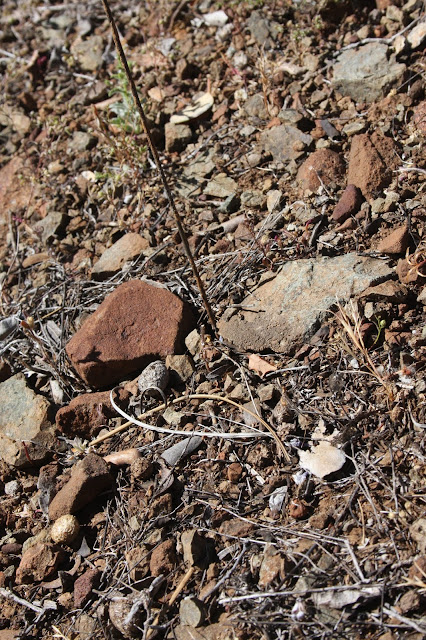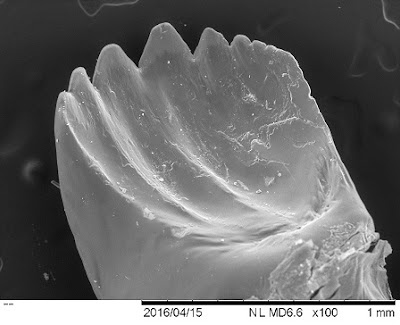Inspired by
this post, I'm going to try to put the results of small (but interesting) experiments up here every once and awhile. In the summer of 2014, I spent a lot of time washing plants. I was - and still am - curious of the function(s) of plant exudates. I primarily did this with
Trichostema laxum and
Atriplex rosea (in
2013), but I also did it with
Mimulus layneae and
Antirrhinum cornutum (California snapdragon). The snapdragon gave me interesting results.
(this post should also be regarded as potential project for someone else: I started it in May - there is plenty of time to get up to McLaughlin and do it again this year).
 |
| One of the experimental A. cornutum, showing leaf damage. |
This snapdragon, while not as heavily glandular as
Trichostema or that
Mimulus, is fairly glandular-sticky, even entrapping a
small number of minute insects (see the table/supplementary material). Under the microscope, you can see the fairly dense short glandular trichomes (the longer trichomes are mostly nonglandular) on the stalk and flower bud.
 |
| Stem of A cornutum with an entrapped insect. |
 |
| Flower bud showing short glandular and long nonglandular trichomes. |
Wondering whether the glandular exudate is defensive, I did an experiment where I removed it with water. Most glandular exudates in CA summer annuals seem water soluble, so a spray bottle rainfall takes off much of the exudate (observationally verified
in situ with a 20x loupe - plus whatever was in this exudate made suds on the plant!). This manipulation was my first treatment group. Of course, adding water to a plant has an effect of its own, so I also had a water control group, where I added the same amount of water below the plant's leaves, as to not wash off any exudates. Finally, I had a true control group, which received no water whatsoever. I instituted these treatments on the 30th of May and reapplied them on the 17th of June. Each time, I recorded the number of leaves, flowers, fruit, and plant height, as well as any damage. I also checked the plants, but did not reapply treatments on the 2nd and 19th of July (the last check all were senescent).
During the experiment, plants suffered two main forms of herbivory. The first type, which was most common and most destructive, was that the stems were entirely clipped off. I'm nearly positive this was by jackrabbits (indicated by a single flat cut diagonally across the stem) and it usually killed the plant. The photos below shows what remained.
 |
| A killed experimental A. cornutum plant. See it?!? Its the little stem to the bottom left of the flag. Also notice a nice healthy Lessingia in the background. They, too, are extremely glandular and sticky. |
 |
| A survivor of mammalian herbivory. If the meristem was not completely destroyed, they often came back and branched like this. Like the classic overcompensation "herbivore-plant mutualisms", the resulting plants were often bigger than the others, with more reproductive structures, but unlike this "mutualism", it was too late in the season and they had low fitness, as they could not mature these structures. |
The mammalian herbivory was not random. Of the 25 plants per treatment, 11 in the control group, 13 in the rainfall simulation (exudate removal) and a whopping 20 in the water control group were eaten by mammals (this is nonlethal, lethally was 10, 12, 18). With a simple chi-squared test, we can demonstrate that this was likely nonrandom (X2 = 7.3688, df =2, p = 0.025) (for lethal, X2 = 5.5714, df=2, p = 0.062). Why were the mammals targetting the water control plants so heavily?
Were they bigger and thus easier to find or just more profitable to eat? They were not significantly different in height, fruit or flower numbers from the other two groups during any check. I don't have data on plant quality (perhaps the less water-limited plants were more nutritious or something?).
The other type of damage was equally-interesting.
Heliothis phloxiphaga is a generalist caterpillar on glandular plants. It was the primary herbivore on my columbines, as well as a common herbivore on
Trichostema laxum and other sticky plants. Like most heliothiine noctuids, it feeds primarily (but not exclusively) on reproductive structures. I only observed it once on
Antirrhinum (eating a fruit), but all the fruit damage I found was consistent with it (and that's one more time than I saw a jackrabbit eat it!).
 |
| The other type of damage: caterpillar fruit predation. |
I had hypothesized, that if the exudate were defensive, the washed plants would be most heavily eaten. This hypothesis was supported with the fruit damage. Rainfall plants received far more damage than the other groups. (note: I didn't actually analyze this with zero-inflated binomial, as it should be. There is a problem, in that only 7/25 of the water control plants had any fruit at all because of the rabbits.)
 |
| A crumby excel graph of proportion fruits damaged. |
What does this all mean? Obviously, it means that mammalian and insect herbivores are responding to different plant traits. What they are exactly, I'm not sure (especially for mammals). If anyone (nudge, nudge, wink, wink) were to repeat this experiment, with a larger sample size, and maybe some other mechanistic experiments (perhaps cage controls and lots more trait data to see what is different in the water control and rainfall manip groups), I think its a pretty good system that someone could get a paper - if not a few - out of.











